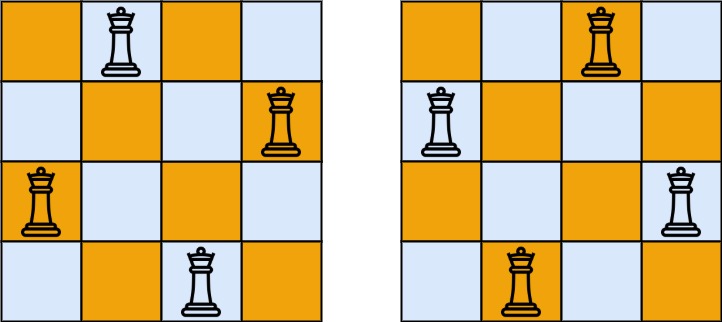The n-queens puzzle is the problem of placing n queens on an n x n chessboard such that no two queens attack each other.
Given an integer n, return all distinct solutions to the n-queens puzzle. You may return the answer in any order.
Each solution contains a distinct board configuration of the n-queens’ placement, where 'Q' and '.' both indicate a queen and an empty space, respectively.
Example 1:

Input: n = 4 Output: [[“.Q..”,”…Q”,”Q…”,”..Q.”],[“..Q.”,”Q…”,”…Q”,”.Q..”]] Explanation: There exist two distinct solutions to the 4-queens puzzle as shown above
Example 2:Input: n = 1 Output: [[“Q”]]
Constraints:
1 <= n <= 9
Java Solution
import java.util.ArrayList;
import java.util.List;
public class NQueens {
public static List<List<String>> solveNQueens(int n) {
List<List<String>> result = new ArrayList<>();
char[][] board = new char[n][n];
for (int i = 0; i < n; i++) {
for (int j = 0; j < n; j++) {
board[i][j] = '.';
}
}
solveNQueensHelper(board, 0, result);
return result;
}
private static void solveNQueensHelper(char[][] board, int row, List<List<String>> result) {
int n = board.length;
if (row == n) {
result.add(constructSolution(board));
return;
}
for (int col = 0; col < n; col++) {
if (isValid(board, row, col)) {
board[row][col] = 'Q';
solveNQueensHelper(board, row + 1, result);
board[row][col] = '.';
}
}
}
private static boolean isValid(char[][] board, int row, int col) {
int n = board.length;
// Check if there is a queen in the same column
for (int i = 0; i < row; i++) {
if (board[i][col] == 'Q') {
return false;
}
}
// Check if there is a queen in the left diagonal
for (int i = row - 1, j = col - 1; i >= 0 && j >= 0; i--, j--) {
if (board[i][j] == 'Q') {
return false;
}
}
// Check if there is a queen in the right diagonal
for (int i = row - 1, j = col + 1; i >= 0 && j < n; i--, j++) {
if (board[i][j] == 'Q') {
return false;
}
}
return true;
}
private static List<String> constructSolution(char[][] board) {
List<String> solution = new ArrayList<>();
for (char[] row : board) {
solution.add(new String(row));
}
return solution;
}
public static void main(String[] args) {
int n1 = 4;
List<List<String>> result1 = solveNQueens(n1);
System.out.println("N = " + n1 + ":\n" + result1);
int n2 = 1;
List<List<String>> result2 = solveNQueens(n2);
System.out.println("N = " + n2 + ":\n" + result2);
}
}
This Java code uses backtracking to explore all possible configurations of placing queens on the chessboard and checks for validity at each step. The solveNQueens method returns a list of distinct solutions for the N-Queens puzzle. The isValid method checks whether placing a queen at a specific position is valid or not. The constructSolution method is used to convert the chessboard configuration to the required format for the result.
Python Solution
def solveNQueens(n):
def is_valid(board, row, col):
# Check if there is a queen in the same column
for i in range(row):
if board[i][col] == 'Q':
return False
# Check if there is a queen in the left diagonal
for i, j in zip(range(row - 1, -1, -1), range(col - 1, -1, -1)):
if board[i][j] == 'Q':
return False
# Check if there is a queen in the right diagonal
for i, j in zip(range(row - 1, -1, -1), range(col + 1, len(board))):
if board[i][j] == 'Q':
return False
return True
def construct_solution(board):
return [''.join(row) for row in board]
def solve_nqueens_helper(board, row, result):
if row == len(board):
result.append(construct_solution(board))
return
for col in range(len(board)):
if is_valid(board, row, col):
board[row][col] = 'Q'
solve_nqueens_helper(board, row + 1, result)
board[row][col] = '.'
result = []
board = [['.' for _ in range(n)] for _ in range(n)]
solve_nqueens_helper(board, 0, result)
return result
# Test cases
n1 = 4
result1 = solveNQueens(n1)
print(f"N = {n1}:\n{result1}")
n2 = 1
result2 = solveNQueens(n2)
print(f"N = {n2}:\n{result2}")
This Python code follows the same backtracking approach as the Java solution. The solveNQueens function returns a list of distinct solutions for the N-Queens puzzle. The is_valid function checks whether placing a queen at a specific position is valid or not, and the construct_solution function converts the chessboard configuration to the required format for the result.
